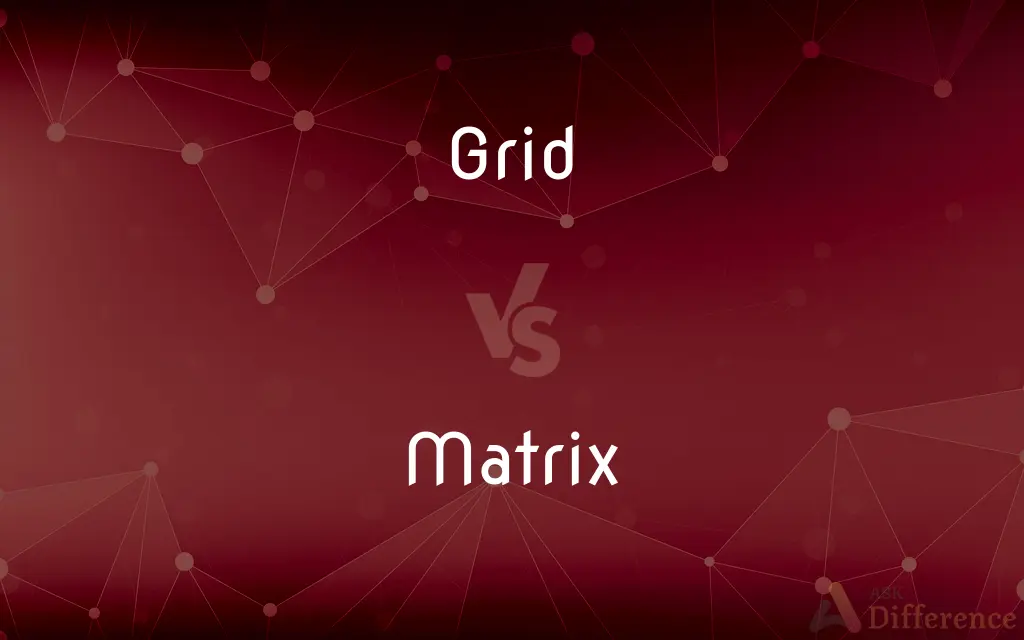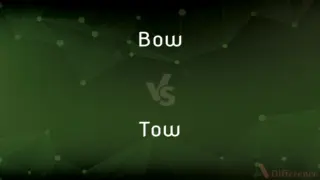Grid vs. Matrix — What's the Difference?
Edited by Tayyaba Rehman — By Fiza Rafique — Updated on April 23, 2024
A grid is a network of intersecting parallel lines, typically used for mapping or layout, while a matrix is a rectangular array of numbers or symbols used in mathematics for complex calculations.

Difference Between Grid and Matrix
Table of Contents
ADVERTISEMENT
Key Differences
A grid consists of horizontal and vertical lines that intersect to form squares or rectangles, commonly used in design and spatial planning, like city layouts or graphic design grids. On the other hand, a matrix is a mathematical concept that includes rows and columns filled with numbers or variables that represent data or perform operations in linear algebra.
Grids are fundamental in various practical applications such as in maps, engineering designs, and digital interfaces, providing a structured method of space organization. Whereas matrices are crucial in mathematics, physics, and computer science for solving systems of equations, transforming coordinates, and manipulating data.
The concept of a grid is often used metaphorically in discussions about various frameworks or systems, emphasizing the importance of structure and regularity. In contrast, a matrix is used in more specialized contexts, often dealing with theoretical or computational problems.
Grids are visual and spatial in nature, used to enhance readability and usability in physical and digital products. In contrast, matrices are abstract and primarily numeric, focusing on calculations and theoretical frameworks in scientific and mathematical fields.
While the structure of a grid can be simple and used for basic organizational tasks, the complexity of a matrix can vary greatly, with its elements capable of representing complex relationships and supporting high-level calculations.
ADVERTISEMENT
Comparison Chart
Definition
Network of intersecting lines forming squares
Rectangular array of numbers or symbols
Usage
Mapping, layout, design
Mathematics, data processing
Function
Organize space, enhance readability
Perform calculations, represent relationships
Composition
Lines intersecting at right angles
Rows and columns of elements
Examples
City grid, graphic design grid
Coordinate transformations, system equations
Compare with Definitions
Grid
Used in design and layout for visual organization.
The graphic designer used a grid to align all elements symmetrically.
Matrix
In biology, a medium or environment in which something develops.
The extracellular matrix provides structural support to cells.
Grid
A pattern of lines for guiding the layout on a page or a screen.
She used a grid on her drawing app to maintain proportions.
Matrix
A tool for statistical analysis and data processing.
The correlation matrix helped identify the relationships between variables.
Grid
A structure of electrical or other networks.
The power grid supplies electricity to the entire region.
Matrix
An array of numbers arranged in rows and columns to form a rectangle.
They used a matrix to solve the system of linear equations.
Grid
Metaphorical use in planning or structure discussions.
The organizational grid of the company was redesigned for better workflow.
Matrix
Used in computer graphics to handle complex transformations.
The rotation of the object was achieved by applying a transformation matrix.
Grid
A framework of spaced bars that are parallel to or cross each other.
The city's streets are laid out in a grid pattern.
Matrix
Essential in mathematical computations and theoretical physics.
Quantum mechanics uses matrix mechanics as a fundamental formulation.
Grid
A framework of crisscrossed or parallel bars; a grating or mesh.
Matrix
The cultural, social, or political environment in which something develops
Oxbridge was the matrix of the ideology
Grid
A cooking surface of parallel metal bars; a gridiron.
Matrix
A mass of fine-grained rock in which gems, crystals, or fossils are embedded
Nodules of secondary limestone set in a matrix of porous dolomite
Such fossils will often be partly concealed by matrix
Grid
Something resembling a framework of crisscrossed parallel bars, as in rigidity or organization
The city's streets form a grid.
Matrix
A mould in which something, such as a record or printing type, is cast or shaped
Her two duets with Isobel Baillie were never issued and the matrices were destroyed
Grid
A pattern of regularly spaced horizontal and vertical lines forming squares on a map, a chart, an aerial photograph, or an optical device, used as a reference for locating points.
Matrix
A rectangular array of quantities or expressions in rows and columns that is treated as a single entity and manipulated according to particular rules
This formula applies for all square matrices
Grid
An interconnected system for the distribution of electricity or electromagnetic signals over a wide area, especially a network of high-tension cables and power stations.
Matrix
An organizational structure in which two or more lines of command, responsibility, or communication may run through the same individual
Matrix structures are said to foster greater flexibility
Grid
A corrugated or perforated conducting plate in a storage battery.
Matrix
A situation or surrounding substance within which something else originates, develops, or is contained
"Freedom of expression is the matrix, the indispensable condition, of nearly every form of freedom" (Benjamin N. Cardozo).
Grid
(Football) The gridiron.
Matrix
The womb.
Grid
(Sports) The starting positions of cars on a racecourse.
Matrix
The formative cells or tissue of a specialized structure such as a hair, nail, claw, or tooth.
Grid
A rectangular array of squares or rectangles of equal size, such as in a crossword puzzle.
Matrix
See ground substance.
Grid
A tiling of the plane with regular polygons; a honeycomb.
Matrix
The solid matter in which a fossil or crystal is embedded.
Grid
A system for delivery of electricity, consisting of various substations, transformers and generators, connected by wire.
Matrix
Groundmass.
Grid
(computing) A system or structure of distributed computers working mostly on a peer-to-peer basis, used mainly to solve single and complex scientific or technical problems or to process data at high speeds (as in clusters).
Matrix
A mold or die.
Grid
(cartography) A method of marking off maps into areas.
Matrix
The principal metal in an alloy, as the iron in steel.
Grid
(motor racing) The pattern of starting positions of the drivers for a race.
Matrix
A binding substance, as cement in concrete.
Grid
(electronics) The third (or higher) electrode of a vacuum tube (triode or higher).
Matrix
(Mathematics) A rectangular array of numeric or algebraic quantities subject to mathematical operations.
Grid
(electricity) A battery-plate somewhat like a grating, especially a zinc plate in a primary battery, or a lead plate in a secondary or storage battery.
Matrix
Something resembling such an array, as in the regular formation of elements into columns and rows.
Grid
A grating of parallel bars; a gridiron.
Matrix
(Computers) The network of intersections between input and output leads in a computer, functioning as an encoder or a decoder.
Grid
An openwork ceiling above the stage or studio, used for affixing lights etc.
Matrix
A mold used in stereotyping and designed to receive positive impressions of type or illustrations from which metal plates can be cast. Also called mat2.
Grid
To mark with a grid.
Matrix
A metal plate used for casting typefaces.
Grid
To assign a reference grid to.
Matrix
An electroplated impression of a phonograph record used to make duplicate records.
Grid
A grating of thin parallel bars, similar to a gridiron.
Matrix
A table of data.
Grid
A plate or sheet of lead with perforations, or other irregularities of surface, by which the active material of a secondary battery or accumulator is supported.
Matrix
The cavity or mold in which anything is formed.
Grid
A mesh or coil of fine wire in an electron tube, connected to the circuit so as to regulate the current passing through the tube.
Matrix
(biology) The material or tissue in which more specialized structures are embedded.
Grid
Any network of crossing horizontal and vertical lines; - they are used, for example, as reference coordinates to locate objects or places on a map.
Matrix
(biology) An extracellular matrix, the material or tissue between the cells of animals or plants.
Grid
Anything resembling a grid{4}, as the Manhattan street grid. See also gridlock.
Matrix
(biology) Part of the mitochondrion.
Grid
A network of connected conductors for distributing electrical power, especially one using high-tension lines for wide geographic distribution of power; as, the Northeast power grid.
Matrix
(biology) The medium in which bacteria are cultured.
Grid
The gridiron.
Matrix
A term describing a controlled environment or situation in which people act or behave in ways that conform to roles pre-determined by a powerful person(s) who decides how the world is supposed to function (as if the world is but virtual reality and people but brains in a vat).
The Matrix has attacked me
Grid
A system of high tension cables by which electrical power is distributed throughout a region
Matrix
(mathematics) A rectangular arrangement of numbers or terms having various uses such as transforming coordinates in geometry, solving systems of linear equations in linear algebra and representing graphs in graph theory.
Grid
A network of horizontal and vertical lines that provide coordinates for locating points on an image
Matrix
(computing) A two-dimensional array.
Grid
An electrode placed between the cathode and anode of a vacuum tube to control the flow of electrons through the tube
Matrix
(electronics) A grid-like arrangement of electronic components, especially one intended for information coding, decoding or storage.
Grid
A cooking utensil of parallel metal bars; used to grill fish or meat
Matrix
(geology) A geological matrix.
Matrix
(archaeology and paleontology) The sediment surrounding and including the artifacts, features, and other materials at a site.
Matrix
(analytical chemistry) The environment from which a given sample is taken.
Matrix
In hot metal typesetting, a mold for casting a letter.
Matrix
In printmaking, the plate or block used, with ink, to hold the image that makes up the print.
Matrix
(dyeing) The five simple colours (black, white, blue, red, and yellow) from which all the others are formed.
Matrix
(material science) A binding agent of composite materials, e.g. resin in fibreglass.
Matrix
The womb.
Matrix
The womb.
All that openeth the matrix is mine.
Matrix
That which gives form or origin to anything
Matrix
The lifeless portion of tissue, either animal or vegetable, situated between the cells; the intercellular substance.
Matrix
A rectangular arrangement of symbols in rows and columns. The symbols may express quantities or operations.
Matrix
A rectangular array of elements (or entries) set out by rows and columns
Matrix
An enclosure within which something originates or develops (from the Latin for womb)
Matrix
The body substance in which tissue cells are embedded
Matrix
The formative tissue at the base of a nail
Matrix
Mold used in the production of phonograph records, type, or other relief surface
Common Curiosities
What is the primary purpose of a grid?
The primary purpose of a grid is to provide a structural layout that organizes space or content in a visually systematic way.
What types of problems are solved using matrices?
Matrices are used to solve problems in linear algebra, physics, computer graphics, and any context requiring complex numerical computations.
Can a grid contain elements other than lines?
Typically, a grid is composed of lines, but it may incorporate additional graphical elements for specific design purposes.
How does the use of grids and matrices differ in technology?
In technology, grids are used for layout and interface design, while matrices are used in algorithms, computations, and data structuring.
How is a matrix used in mathematics?
In mathematics, a matrix is used to perform calculations, solve systems of equations, and represent complex numerical relationships.
How are grids and matrices similar?
Both grids and matrices involve organizing elements in a structured format; however, grids are spatial and visual, while matrices are numerical and abstract.
Why are matrices important in computer graphics?
Matrices are crucial in computer graphics for transformations such as rotation, scaling, and translation of objects in a three-dimensional space.
What practical applications do matrices have outside of pure mathematics?
Outside of pure mathematics, matrices are used in economics for input-output models, in engineering for structural analysis, and in science for modeling physical systems.
Is knowledge of matrices necessary for programming?
Knowledge of matrices is essential for certain areas of programming, especially in fields like machine learning, graphics, and scientific computing.
Can matrices be visualized as grids?
Yes, matrices can be visualized as grids of numbers, helping to conceptualize their structure and function in a more tangible way.
What is an example of a grid in everyday life?
An everyday example of a grid is the layout of streets in many cities, especially those planned with a clear, rectangular grid pattern.
What skills are necessary to work effectively with grids?
Skills in spatial reasoning, design, and planning are necessary to use grids effectively in various fields such as architecture, graphic design, and urban planning.
What foundational mathematical concepts are related to matrices?
Matrices are closely related to concepts such as vectors, determinants, and eigenvalues in mathematics.
How are grids applied in digital design?
In digital design, grids are used to create balanced layouts, ensure consistent spacing, and align elements effectively across different screen sizes.
How does one create a matrix for a specific calculation?
Creating a matrix for a specific calculation involves defining the matrix's size (rows and columns) and populating it with numerical values relevant to the problem being solved.
Share Your Discovery

Previous Comparison
Bow vs. Tow
Next Comparison
Teaser vs. TrailerAuthor Spotlight
Written by
Fiza RafiqueFiza Rafique is a skilled content writer at AskDifference.com, where she meticulously refines and enhances written pieces. Drawing from her vast editorial expertise, Fiza ensures clarity, accuracy, and precision in every article. Passionate about language, she continually seeks to elevate the quality of content for readers worldwide.
Edited by
Tayyaba RehmanTayyaba Rehman is a distinguished writer, currently serving as a primary contributor to askdifference.com. As a researcher in semantics and etymology, Tayyaba's passion for the complexity of languages and their distinctions has found a perfect home on the platform. Tayyaba delves into the intricacies of language, distinguishing between commonly confused words and phrases, thereby providing clarity for readers worldwide.














































